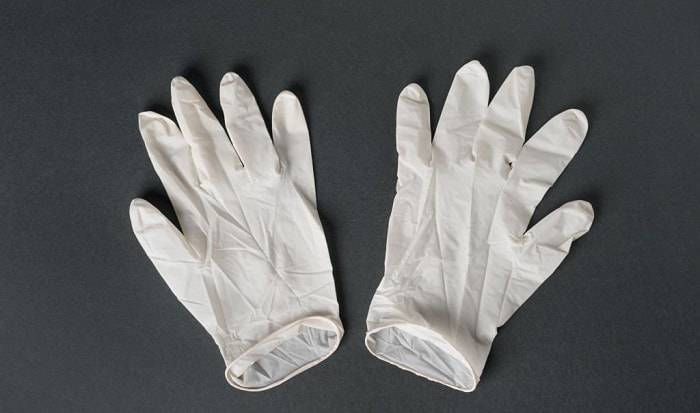Nitrile gloves are essential in various settings, from home to industrial uses. Their application is plentiful, ranging from medical services to laboratories, industrial plants, cleaning, and food services. Most of us are familiar with disposable nitrile gloves and their protective features against dirt, moisture, certain chemicals, etc.
Furthermore, these gloves are also affordable, allowing frequent glove changes in certain tasks. Given the huge demand and use of this product, it is understandable to worry about its impact on our environment.
So, how long does it take nitrile gloves to decompose? If left decomposed naturally, it takes nitrile a century to break down entirely.
Table of Contents
Decomposition of Disposable Nitrile Gloves
One piece of disposable nitrile gloves takes up to 100 years to completely decay. In the process, nitrile emits toxic chemicals, including butadiene and acrylonitrile, to the air and water.
Discarding nitrile gloves near living areas risks harming the health of people due to contamination.
- Acrylonitrile in nitrile gloves composition, when released into residents’ drinking water, can cause symptoms like nausea and dizziness. People are prone to headaches when they absorb this toxic compound.
- Butadiene – the other chemical emitted when the glove decays, is to blame for various health issues. Exposure to this compound, either in the air or water, might lead to throat and eye irritation, potentially hurting our respiratory system in the long term.
Even when disposed of in the right place, emission of these toxic compounds into nature will contribute to environmental pollution. The Nitrile gloves environmental impact is severe due to mass production, use, and littering.
Are Latex and Vinyl Gloves Eco-friendly?
Just like nitrile, vinyl and latex gloves are not good for the environment, even though they are important for industrial and professional uses.
Latex is made from rubber plant, a natural material. Therefore, these gloves are considered biodegradable. However, in the decomposing process that takes five years, these biodegradable latex gloves are also harmful to the soil and nature.
Vinyl is a non-biodegradable synthetic material that takes years to break down. They are stubborn substances that, depending on the types of polymers in their formulation, take much longer than latex gloves to decompose.
Are There Eco Friendly Disposable Gloves?
The good news is that eco-friendly or biodegradable disposable gloves are widely available in the market. They are formulated to reduce the severe impact of usual disposable gloves, especially nitrile and vinyl, on the environment.
1. They are formulated from safe materials
In fact, biodegradable plastic gloves are made of renewable or all-natural materials. Instead of using toxic compounds that take years to decompose, these gloves are constructed from familiar materials collected from nature, including tapioca, corn, roots, sugar beet pulp, or cassava.
Furthermore, with these sources of materials, manufacturers use less petroleum than in making standard plastic products. It is another way to save energy and reduce hazardous waste.
2. They decompose quickly and easily
Biodegradable gloves decay when exposed to light and oxygen, taking only several months to decompose completely. This saves money and energy used for decomposing disposable gloves, as creating high temperatures in standard industrial settings can complete the process.
There are also biodegradable nitrile gloves, which are formulated to reduce the decomposition period to under 5 years, thus minimizing the contamination.
3. They leave zero waste
Unlike standard nitrile gloves, biodegradable pairs are formulated with organic materials. When discarded in landfills, these organic materials allow microorganisms to eat and break them down.
In the process, there are no toxic chemicals left. Instead, methane, carbon dioxide, and organic soil that are broken down from the gloves will become fertilizer for the land.
4. They are safe and versatile
It might surprise you that these biodegradable gloves are just as functional and protective as the standard disposable gloves made of nitrile, latex, and vinyl.
They are just as durable and flexible, offering a good grip and dexterity for intricate tasks. These gloves can resist punctures, rips, and tears well to prevent direct contact of harmful fluids and chemicals with our hand skin.
Without latex in the formula, these biodegradable products are used as medical gloves to treat patients without the risk of triggering allergies. They are also food-grade gloves for processing fresh ingredients and handling cooked food.
Furthermore, these gloves have good strength, sufficient for use in various industrial settings, including landscaping, automotive, manufacturing, agriculture, etc.
https://youtu.be/TGgncsoo4Z4
Conclusion
So, instead of asking questions like “How long does it take nitrile gloves to decompose?” or “do vinyl gloves decompose?” and worrying about their lasting impact on the environment, you can opt for biodegradable gloves made of natural and raw materials.
When we are aware of their helpful features and safe use, it is better to select them for our daily tasks around the house and at the worksite. Make sure you choose a reliable brand or manufacturer to get your biodegradable gloves.
Feel free to share this article with your friends to spread the word about using biodegradable products for a sustainable future.

This is Edward Manning, the editor in chief of Construction Informer. Quite a bit of my time is spent researching the market and interviewing experts in the field so that I can give you reliable information.




